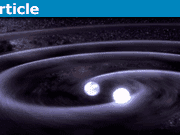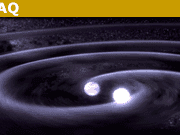Maxwell’s Equations in a Static, Spherically Symmetric Spacetime
In the first article in this series, we looked at the Einstein Field Equations in a static, spherically symmetric spacetime. In this article, we are going to build on what we saw in the first article to show what Maxwell’s Equations in a static, spherically symmetric spacetime look like.
The electromagnetic field tensor is given in general by
[tex]F_{ab} = \partial_b A_a – \partial_a A_b[/tex]
where [itex]A_a[/itex] is the electromagnetic 4-potential.
In covariant form, Maxwell’s Equations in general are:
[tex]\partial_c F_{ab} + \partial_b F_{ca} + \partial_a F_{bc} = 0[/tex]
[tex]\nabla_a F^{ab} = \partial_a F^{ab} + \Gamma^a{}_{ac} F^{cb} = 4 \pi j^b[/tex]
The first equation is an identity given the definition of ##F_{ab}##; the second equation links the EM field to its source, the charge-current 4-vector ##j^b##, and is the one we will be focusing on here.
Note, btw, that we don’t need covariant derivatives in the first equation, even in a general curved spacetime, because the connection coefficient terms all cancel since [itex]F_{ab}[/itex] is antisymmetric and the connection coefficients are symmetric in the two lower indexes. Similarly, in the second equation, the second connection coefficient term that would normally appear, [itex]\Gamma^b{}_{ac} F^{ac}[/itex], is identically zero for an antisymmetric tensor.
The general form of the stress-energy tensor for an electromagnetic field is
[tex]T^a{}_b = \frac{1}{4 \pi} \left( F^{ac} F_{bc} – \frac{1}{4} \delta^a{}_b F^{cd} F_{cd} \right)[/tex]
which requires us to raise two indexes on the EM field tensor, as follows:
[tex]F^{ab} = g^{ac} g^{bd} F_{cd}[/tex]
To specialize the above to the static, spherically symmetric case, we note first that, since the only coordinate on which anything can depend is [itex]r[/itex], the only possible nonzero components of the EM field tensor are
[tex]F_{rt} = – F_{tr} = – \partial_r A_t = E[/tex]
[tex]F_{r \theta} = – F_{\theta r} = – \partial_r A_\theta = B[/tex]
[tex]F_{r \phi} = – F_{\phi r} = – \partial_r A_\phi = B[/tex]
where we have defined useful symbols for the components based on their obvious physical interpretations. The last two components must be equal by spherical symmetry; however, it would be really nice if we could prove, what seems intuitively correct, that they must be zero.
We can, as it turns out, do this by looking at the stress-energy tensor components. We know, from the first article in this series, that the SET for a static, spherically symmetric spacetime must be diagonal (since the Einstein tensor is diagonal). But if the angular components of the EM field tensor are nonzero, then we would have nonzero off-diagonal terms in the SET such as this one:
[tex]T^\theta{}_\phi = \frac{1}{4 \pi} F^{\theta r} F_{\phi r}[/tex]
(where the second term in the general formula for the SET is identically zero here because of the [itex]\delta^a{}_b[/itex] in front). So the angular terms in the EM field tensor must be zero, and we have [itex]F_{rt} = – F_{tr} = E[/itex] as the only nonzero terms. This EM field tensor describes a static, spherically symmetric, radial electric field, where we have
[tex]A_t = \varphi (r)[/tex]
for the 4-potential, with all other components zero, and
[tex]F_{rt} = – F_{tr} = E = – \partial_r \varphi[/tex]
for the EM field tensor, as above, and
[tex]- T^t{}_t = – T^r{}_r = T^\theta{}_\theta = T^\phi{}_\phi = \rho_{EM} = \frac{E^2}{8 \pi} \left( \frac{r – 2m}{r J} \right)[/tex]
for the stress-energy tensor, where we have used the equation from the first article for the metric. Note that this describes a “substance” with positive energy density (remember the sign switch in [itex]T^t_t[/itex] due to the metric signature), a negative radial stress (i.e., a radial tension), and a positive tangential stress (i.e., a tangential pressure), all with the same magnitude. (Notice that this is equivalent to specifying ##s = – p = \rho## for the SET components as described in the first article, at least for the portion of the SET that is due to the EM field.)
We can now write down the second Maxwell Equation taking into account all of the above; the only nonzero component is the [itex]t[/itex] component, which is:
[tex]\nabla_a F^{at} = 4 \pi j^t = \partial_a F^{at} + \Gamma^a{}_{ac} F^{ct} = \partial_r F^{rt} + \Gamma^a{}_{ar} F^{rt}[/tex]
Expanding this out gives:
[tex]4 \pi j^t = \left[ \partial_r + \Gamma^t{}_{tr} + \Gamma^r{}_{rr} + \Gamma^\theta{}_{\theta r} + \Gamma^\phi{}_{\phi r} \right] \left( g^{tt} g^{rr} F_{rt} \right)[/tex]
Substituting and tedious but straightforward algebra gives:
[tex]4 \pi j^t = – \frac{r – 2m}{rJ} \frac{dE}{dr} – \frac{1}{J}\left[ \frac{2 \left( r – 2m \right)}{r^2} + 4 \pi r \left( \rho + p \right) \left( 1 – \frac{2 \left( r – 2m \right)}{r J} \right) \right] E[/tex]
We note that ##\rho## and ##p## appear in the above, and we will find it useful to split them into the part due to the EM field and a separate part due to whatever other matter (or other source of stress-energy) is present. Thus we define ##\rho = \rho_{EM} + \rho_m## and ##p = p_{EM} + p_m##, and we note that ##\rho_{EM} + p_{EM} = 0##. That allows us to rearrange the above equation in a way that will often be useful:
[tex]j^t = – \frac{1}{4 \pi} \frac{r – 2m}{rJ} \left( \frac{dE}{dr} + \frac{2}{r} E \right) – \left( \rho_m + p_m \right) E \left( \frac{r}{J} – \frac{2 \left( r – 2m \right)}{J^2} \right)[/tex]
Finally, as we did in the previous article, we look at the special case where no charge or current density is present, and also no stress-energy is present other than that contained in the electromagnetic field. For this case, we have ##j^t = 0##, which means that we must have ##dE / dr = – 2 E / r##. The solution to this differential equation for ##E## is ##E = Q / r^2##, where ##Q## is a constant with units of length. This in turn gives ##A^t = \phi = Q / r##. These are recognizable as the potential and electric field of a point charge ##Q## at ##r = 0##; the only difference is that we have the charge in “geometric units” instead of conventional units.
For this value of ##E##, we have
$$
\rho_{EM} = \frac{E^2}{8 \pi} \left( \frac{r – 2m}{r J} \right) = \frac{Q^2}{8 \pi r^4} \left( \frac{r – 2m}{r J} \right)
$$
We can combine all this with the equations for the EFE that we derived in the previous article to obtain equations for ##J(r)## and ##m(r)##, the only remaining unknown functions for this special case. First, we have ##dm / dr = 4 \pi r^2 \rho_{EM}##, which gives
$$
\frac{dm}{dr} = 4 \pi r^2 \frac{Q^2}{8 \pi r^4} \left( \frac{r – 2m}{r J} \right) = \frac{Q^2}{2 r^2} \left( \frac{r – 2m}{r J} \right)
$$
Second, we have, using ##p = – \rho_{EM}##,
$$
\frac{1}{2J} \frac{dJ}{dr} = \frac{m + 4 \pi r^3 p}{r \left( r – 2m \right)} = \frac{m – \frac{Q^2}{2 r} \left( \frac{r – 2m}{r J} \right)}{r \left( r – 2m \right)} = \frac{m – r \frac{dm}{dr}}{r \left( r – 2m \right)}
$$
Using the principle that, when guessing the solution of a problem, it helps to already know the answer, we guess that the above equations will be solved by
$$
m(r) = M – \frac{Q^2}{2r}
$$
and
$$
J(r) = 1 – \frac{2m(r)}{r} = 1 – \frac{2M}{r} + \frac{Q^2}{r^2}
$$
where ##M## is a constant (and plays the same role as in the case of Schwarzschild spacetime). This gives ##\rho_{EM} = Q^2 / 8 \pi r^4##. Of course this is just Reissner-Nordstrom spacetime, and a theorem similar to Birkhoff’s theorem tells us that it is the unique solution to the Einstein-Maxwell equations for the spherically symmetric case.
As a further check, we look at the generalized TOV equation for this special case; the ##\rho + p## term drops out and we have
$$
\frac{dp}{dr} = – \frac{2}{r} \left( p – s \right)
$$
which, using ##-p = s = \rho_{EM} = Q^2 / 8 \pi r^4##, gives
$$
– \frac{d}{dr} \left( \frac{Q^2}{8 \pi r^4} \right) = \frac{2}{r} 2 \left( \frac{Q^2}{8 \pi r^4} \right)
$$
This is easily seen to be valid, so we have indeed shown that our math works out correctly for this special case.
One final comment on physical interpretation: you might have noticed that the function ##m(r)## decreases as ##r## decreases. This in itself is reasonable: as ##r \rightarrow \infty##, ##m(r) \rightarrow M##, which makes sense since ##M## is supposed to be the externally measured mass of the system, and since there is stress-energy present due to the static electric field, we expect ##m(r)## to decrease as ##r## decreases, since more and more of the stress-energy in the electric field will be outside of ##r## and will therefore not contribute to the mass at ##r## (because of the shell theorem and the spherical symmetry). In other words, the externally measured mass ##M## includes a contribution from the stress-energy in the electric field, as it should.
However, as ##r \rightarrow 0##, we have ##m(r) \rightarrow – \infty##, which doesn’t seem to make sense. To put it another way, we can see that ##m(r) = 0##, not at ##r = 0## as we would intuitively expect, but at ##r = Q^2 / 2M##. Mathematically, this is not an issue, since ##r = 0## is not part of the manifold and ##m(r)## is finite at any ##r > 0##. But physically it does not seem to be reasonable.
The key thing to note here is that the value of ##r## at which ##m(r) = 0## will always be inside the inner event horizon ##r_{-} = M – \sqrt{M^2 – Q^2}##. And it is generally accepted that Reissner-Nordstrom spacetime is not physically reasonable at or inside the inner event horizon. (The reasons why are too long to fit into the margin of this article.) So for the portion of the spacetime that is physically reasonable, we will always have ##m(r) > 0##, and we can safely use the standard interpretation of ##m(r)## as the mass inside radius ##r##.
(Note also that some sources will attribute the fact that ##m(r)## is negative inside a certain value of ##r## to “gravitational repulsion” due to the negative radial pressure–for example, see Chapter 8 of Andrew Hamilton’s General Relativity, Black Holes, and Cosmology. If one is willing to consider the spacetime at values of ##r## this small at all, putting aside the fact that, as above, it is not considered physically reasonable, then one can indeed interpret a negative ##m(r)## as corresponding to repulsive rather than attractive gravity. It turns out that radial geodesics this far inside the Reissner-Nordstrom geometry are indeed repelled from ##r = 0##, but where they go after that is beyond the scope of this article.)
- Completed Educational Background: MIT Master’s
- Favorite Area of Science: Relativity










$$\nabla_{b} F^{ab}=\frac{1}{\sqrt{-g}} \partial_b (\sqrt{-g} F^{ab}),$$
i.e., the covariant "divergence" can be written in terms of partial derivatives. Admittedly here you indeed need the metric, because ##g=\mathrm{det}(g_{ab})##.
It's true for the definition
$$F_{ab}=\partial_aA_b-\partial_bA_a \;\;\; (1)$$
and for the mathematical identity
$$\partial_{\{a}F_{bc\}}=0 \;\;\; (2)$$
but not for the physical assumption of no source
$$\nabla_bF^{ab}=0 \;\;\; (3) $$
Eq. (3) cannot be derived from (2). Eqs. (1) and (2) are pure geometry, but (3) is physics. You need metric to raise indices in getting ##F^{ab}## from ##F_{ab}##, so the covariant derivative in (3) cannot be replaced with the ordinary derivative.
While it is true that MTW does give that equation in this form, it turns out that the connection coefficients all cancel, so the equation is still valid in curved spacetime with just partial derivatives. See exercise 22.8.
If you are referring to the fact that the connection coefficients all vanish in certain coordinate charts, the reason for that has nothing to do with a coordinate basis vs. a non-coordinate basis. It has to do with using Riemann normal coordinates (in which the metric is Minkowski and the connection coefficients all vanish) in a local patch of spacetime vs. some other chart.
However, as above, in the particular case of Maxwell's Equations, none of that matters, since the connection coefficient terms, even if they would be present in the particular chart being used, all cancel.
I haven't checked Wald, but in MTW, equation (3.32) is exactly what I wrote down; it has partial derivatives, not covariant derivatives. With partial derivatives, the equation is obviously an identity because of the antisymmetry of ##F## and the commutation of partial derivatives.
In the language of differential forms, which MTW also discusses, the first Maxwell equation is ##\mathbf{d} \mathbf{F} = 0##, which is an identity because ##\mathbf{F} = \mathbf{d} \mathbf{A}##. Writing this out in component form again leads to the form I gave, with partial derivatives.
$$\nabla_c F_{ab} + \nabla_b F_{ca} + \nabla_a F_{bc} = 0$$
While I believe this is equivalent to what Peter wrote in a coordinate basis, I don't think it's equivalent in a general basis.
I.e. in a coordinate basis we can replace the above with the simpler
$$\partial_c F_{ab} + \partial_b F_{ca} + \partial_a F_{bc}$$
but if we use a non-coordinate basis (for instance, an orthonormal basis), we need to keep the covariant derivative.
What it says in the article. If you don't know what terms like "the Einstein Field Equation" refer to, you need to spend some time studying a basic GR textbook. Sean Carroll's online lecture notes are a good introduction to the subject.
If you write it with both indexes up or both indexes down, the metric will appear (which in a general curved spacetime will be ##g_{\mu \nu}## or ##g^{\mu \nu}##, not ##\eta_{\mu \nu}## or ##\eta^{\mu \nu}##). But if you write it with one index up and one index down, as I did, then the metric becomes ##\delta^\mu{}_\nu##.
Yes. You can find it in many references, including MTW, which is where I first saw it.
How are you calculating it?
These are possible, but beyond the intended scope of this particular article. The article is only intended to cover the standard classical Einstein-Maxwell equations.
Is any of this relevant if you assume purely classical EM? It looks like it is all QED corrections to Maxwell EM.